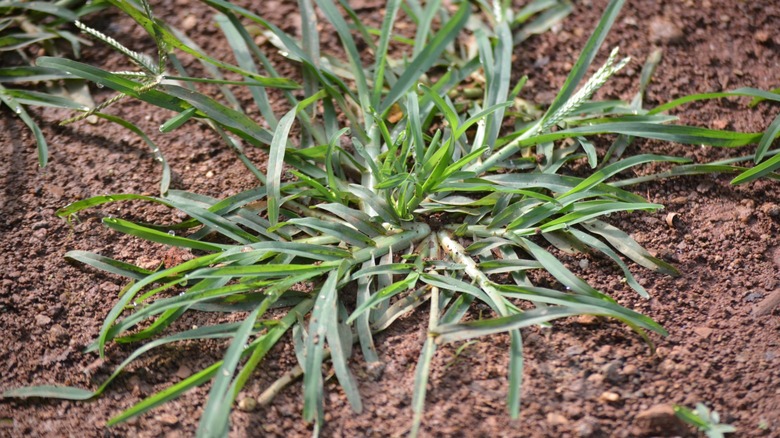Must-Know Lawn Care Tips That'll Help Control Goosegrass In Your Yard
A low-growing, tufted grass species, goosegrass (Eleusine indica) grows in the warm season and is often seen around golf courses, lawns, parks, and athletic fields. An annual weed, you'll see it pop up in the summer almost anywhere thanks to its adaptability. Controlling goosegrass in your yard can be difficult, but not impossible, with the right methods. There are several mechanical ways to get rid of this weed, including hand-pulling. Chemical methods like spraying a herbicide can control larger invasions of goosegrass.
When controlling goosegrass, it's especially important to do everything to minimize the conditions that make the weed overtake a lawn. First and foremost, mowing your turfgrass too short will create favorable conditions for weeds to become established, including goosegrass. If you have healthy grass without any bare spots, there is less space for annual weed seeds to germinate successfully. Stay abreast of mowing techniques that effectively control pesky weeds, like mowing when weeds are dormant to prevent seed germination. Goosegrass seeds can also travel on lawn maintenance equipment and shoes, which makes it easier to bring into your yard unknowingly.
Best practices for managing a goosegrass invasion
If goosegrass pops up uninvited in your yard and there's only a few plants to take care of, hand-pulling can do the trick. A hand-held weeder, a tool that beginning gardeners absolutely need, is also effective at removing small, young infestations by the roots. You can also focus on improving the soil through aeration and reducing foot traffic. Prolific goosegrass growth can tell you a lot about the health of your soil. Weeds like goosegrass are less likely to find a foothold in your lawn if your turf is well-fertilized and properly irrigated. Always choose turfgrass varieties that are adapted to your environment, because thriving turf leaves no space for weedy grasses.
Dealing with more established goosegrass infestations can require more chemical controls. For anyone living in an area with a known problem with goosegrass, consider the benefits of pre-emergent herbicide. If you time application in late winter or early spring prior to goosegrass' seed germination, you can prevent a widespread invasion. Look for a pre-emergent herbicide with active ingredients like benefin, dithiopyr, oxadiazon, or prodiamine. If goosegrass is actively growing in your yard, a post-emergent herbicide with active ingredients like mesotrione, topramezone, or fenoxaprop can be useful as long as you cover the entire plant. Check labels for proper application methods and tips. But if you want more ways to control goosegrass without chemicals, banish weeds for good with the help of stunning, low-maintenance plants, including ground covers like plumbago and creeping thyme.

